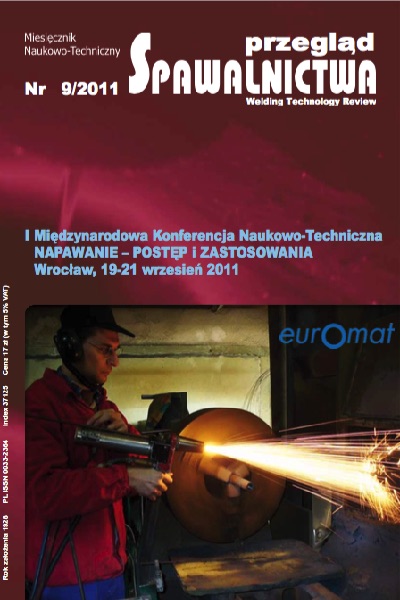Regeneracja zaworów silników okrętowych metodą napawania laserowego
##plugins.themes.bootstrap3.article.main##
Abstrakt
Analizowano możliwości zastosowania napawania laserowego proszkiem na bazie kobaltu przylgni zaworu wylotowego okrętowego silnika Diesla. Po przygotowaniu przez obróbkę skrawaniem, wyselekcjonowane zawory poddano napawaniu laserowemu z wykorzystaniem lasera wysokiej mocy ROFIN DL020. Do napawania użyto proszku EuTroLoy 16012. Jeden z zaworów został pocięty i poddany badaniom metalograficznym oraz pomiarom twardości, a pozostałe zawory zostały zainstalowane w silniku okrętowym, w którym pracowały przez ok. 3000 h. Badania przeprowadzone dla stanu wyjściowego wykazały typową strukturę dendrytyczną napoiny, charakterystyczną dla warstw napawanych, z równomiernie rozłożonymi wydzieleniami węglików w obszarach międzydendrytycznych oraz w minimalnym stopniu zmienioną strukturę w podłożu stalowym. Analogiczne badania wykonano dla zaworów po okresie eksploatacji. Przylgnie zaworów wykazywały niewielkie efekty zużycia. W mikrostrukturze napoiny stwierdzono nieznaczne zmiany spowodowane głównie efektami pro- cesów dyfuzyjnych zachodzących w temperaturze pracy oraz spadek twardości. Technika napawania laserowego okazała się bardzo przydatna do regeneracji zaworów silników okrętowych.
Regeneration of marine engine valves using laser hard-facing
We analyzed the applicability of cobalt-based powder laser hard-facing of exhaust valve face of marine diesel engine. After preparation by machining, using of high-power Rofin DL020 laser selected valves were hard-facing. The EuTroLoy 16012 powder were used. One of the valves were cut and subjected to metallographic examina- tions and hardness measurements, while the other valves were assembled in the engine, which worked for about 3000 h. The tests conducted for the baseline showed a characteristic for surfaced layers dendritic structure of the overlay with carbides uniformly deposited in interdendritic areas and minimally changed the structure of the substrate steel. A similar study conducted for the valves after the operation. Valves face showed a little effects of wear. The microstructure of the deposit was found mostly minor changes due to the effects of diffusion processes occurring in the operating temperature and a decrease of hardness. Laser hard-facing technique has proven very useful for the regeneration of marine engine valves.
Pobrania
##plugins.themes.bootstrap3.article.details##
Creative Commons CC BY 4.0 https://creativecommons.org/licenses/by/4.0/
Artykuły czasopisma Welding Technology Review (Przegląd Spawalnictwa) publikowane są w otwartym dostępie na licencji CC BY (licencja Creative Commons Uznanie autorstwa 4.0 Międzynarodowe). Licencja CC BY jest najbardziej otwartą dostępną licencją i uważaną za „złoty standard” w formule otwartego dostępu; jest również preferowany przez wielu fundatorów badań. Licencja ta umożliwia czytelnikom kopiowanie i redystrybucję materiału na dowolnym nośniku i w dowolnym formacie, a także zmienianie, przekształcanie lub budowanie na nim materiału, w tym do użytku komercyjnego, pod warunkiem wskazania oryginalnego autora.
Bibliografia
Kolaska H., DreyerK.: Metall 45 (1991) 224.
Schlager D., Theiler C., Kohn H.; Protection against high temperature corrosion with laser welded claddings, applied and tested on exhaust valve discs of large diesel engines burning heavy fuel oil; Materials and Corrosion 53, 103÷110 (2002).
Kawana, H. Ichimura, Y. Iwata, S. Ono; Development of PVD ceramic coatings for valve seats; Surface and Coatings Technology 86-87 (1996) 212-217.
Elliott P.; Choose materials for high-temperature environments; Chemical Engineering Progress; New York; Feb 2001, Vol. 97 (2).
Ming-xi Li, Yi-zhu He, Guo-xiong: Laser cladding Co-based alloy/SiCp composite coatings on IF steel; Sun Materials and Design, 25 (2004) 355-358.
Peidao D., Jianglong L., Gongqi S., Shouze Z., Pengjun C.; Laser surface alloing of a low alloy steel with cobalt; Journal of Materials Processing Technology, 58 (1996) 131-135.
Gemelli E., Gallerie A., Caillet M.: Improvement of Resistance to Oxidation by Laser Alloying on a Tool Steel; Scripta Materialia, Vol. 39, No. 10, (1998) 1345-1352.
Kvernes: In: Coatings for high temperature applications (Eds. E. Lang), Elsevier Applied Science Publishers, London and New York 1983, 361-394.
Hidouci, Pelletier J.M., DucoinF., Dezert D., Guerjouma R. E: Microstructural and mechanical characteristics of laser coatings; Surface and Coatings Technology, 123 (2000).
Jendrzejewski R., Conde A., De Damborenea J., Sliwinski G.; Characterisation of the laser-clad stellite layers for protective coatings; Materials and Design, 23 (2002).
Sprawozdanie z pracy naukowo-badawczej pt.: Opracowanie warunków technologicznych napawania laserowego i plazmowego proszkami na osnowie kobaltu, przylgni grzybków zaworów ze stali X40CrSiMo10-2 oraz wykonanie partii próbnej zaworów GRANT KBN 015721 4TO8C 06224.
Smolenska H.; The elevated temperatures influence on the cobalt base cladding layer; Inżynieria Materiałowa. 2010, nr 3(175), s. 366-368.
Kończewicz W., Smoleńska H.: The resistance investigation of the marine engine exchaust valve using the modelling chamber; Journal of Kones Powertrain and Transport. Vol. 15, nr 4 (2008), s. 255-262.
